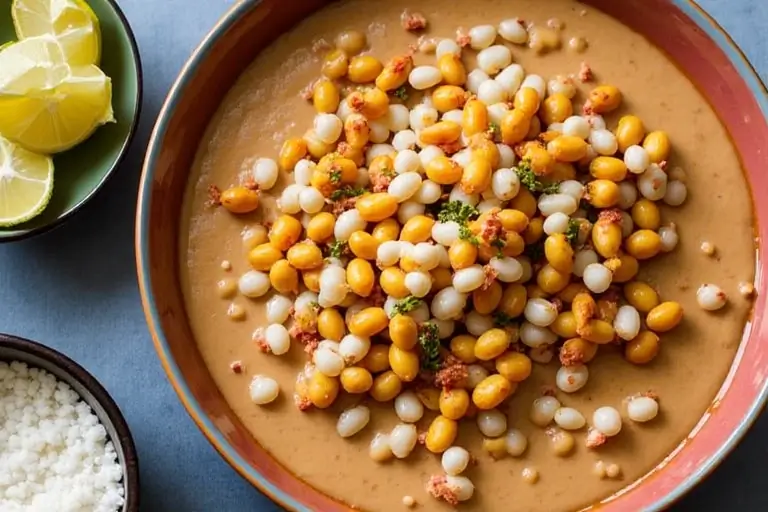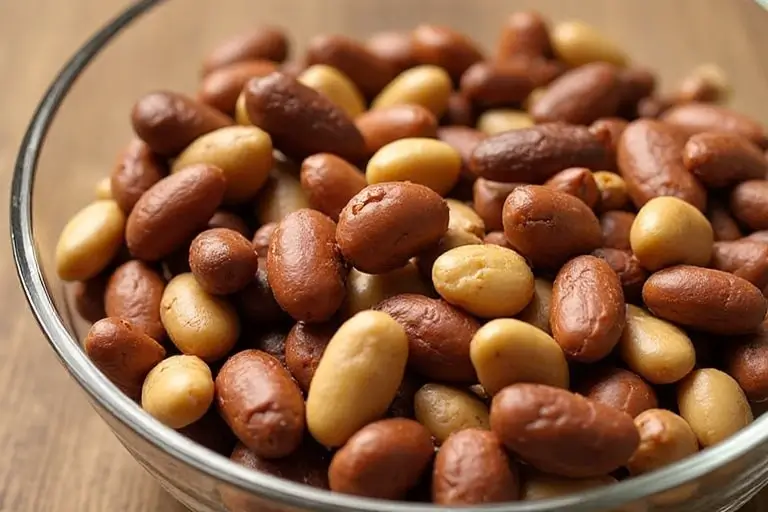Discover the unique pinquito bean, a California treasure. Learn how to cook, serve, and appreciate these tiny, mighty legumes.
Pinquito beans are small pink beans. They are primarily grown in Santa Maria Valley, California. These beans are not as widely known as other varieties. However, they have a devoted following. This is due to their unique flavor.
The History and Heritage: A Santa Maria Valley Treasure
The Unique Terroir of Santa Maria Valley
The Santa Maria Valley boasts a unique microclimate. This is crucial to the pinquito bean’s character. The valley experiences cool, foggy mornings. These are followed by warm, sunny afternoons. The soil is also specific. It contributes to the beans’ distinctive flavor. Consequently, this terroir is irreplaceable.
From Native American Staples to Modern Cuisine
The history of beans in the Americas is long. Indigenous peoples cultivated various beans for centuries. Specifically, it may have evolved from earlier varieties. They have adapted to the Santa Maria Valley’s conditions. While the exact timeline is unclear, their local importance is undeniable.
Pinquito Beans and the Rise of Santa Maria-Style Barbecue
Santa Maria-style barbecue is a regional tradition that gained prominence in the mid-20th century. Pinquito beans became an integral part of this culinary style. The barbecue typically features tri-tip seasoned with a simple dry rub. It is then grilled over red oak. Pinquito beans are almost always served alongside.
Preserving a Culinary Legacy: Supporting Local Growers
The continued cultivation is important. It preserves a piece of California’s culinary heritage. Supporting local growers is crucial. It ensures the survival of this unique bean. It also helps maintain the region’s agricultural traditions. Therefore, seeking out authentic pinquito beans is beneficial.
PrintUnlocking the Secrets of Pinquito Beans: Flavor, Recipes, and More!
- Total Time: 1 hour 55 minutes (plus soaking)
- Yield: 4 servings 1x
- Diet: Vegan
Description
A savory and hearty dish made with classic California-grown pinquito beans. Perfect as a side for barbecue, tacos, or served with rice for a wholesome meal.
Ingredients
1 cup dried pinquito beans
4 cups water (plus more for soaking)
1 small onion, chopped
2 cloves garlic, minced
1/2 teaspoon ground cumin
1/2 teaspoon smoked paprika
1/4 teaspoon dried oregano
1 bay leaf
Salt and pepper to taste
1 tablespoon olive oil
Optional: 1/4 cup tomato sauce or chopped tomatoes
Optional: chopped cilantro or green onions for garnish
Instructions
1. Rinse and sort the dried beans. Soak overnight in plenty of water, or use a quick soak method.
2. Drain soaked beans and add to a pot with 4 cups of fresh water.
3. Add chopped onion, garlic, cumin, paprika, oregano, and bay leaf.
4. Bring to a boil, then reduce heat and simmer, partially covered, for about 1.5 to 2 hours or until beans are tender.
5. Add salt and pepper to taste during the last 15 minutes of cooking.
6. If using, stir in tomato sauce or chopped tomatoes and olive oil. Simmer for 10 more minutes.
7. Remove bay leaf and serve warm, garnished with herbs if desired.
Notes
Pinquito beans are traditionally served with Santa Maria-style barbecue.
You can cook these in a pressure cooker for faster results—about 30 minutes on high pressure.
Leftovers keep well and taste even better the next day.
- Prep Time: 10 minutes
- Cook Time: 1 hour 45 minutes
- Category: Side Dish
- Method: Stovetop
- Cuisine: Californian
Nutrition
- Serving Size: 1 cup
- Calories: 190
- Sugar: 2g
- Sodium: 220mg
- Fat: 4g
- Saturated Fat: 0.5g
- Unsaturated Fat: 3g
- Trans Fat: 0g
- Carbohydrates: 28g
- Fiber: 9g
- Protein: 10g
- Cholesterol: 0mg
Keywords: pinquito beans, Santa Maria beans, barbecue side, California beans
Deep Dive into the Flavor and Texture
A Unique Taste Sensation: Beyond the Ordinary Bean
Pinquito beans offer a flavor that’s hard to replicate. They possess a subtle sweetness. This is balanced by a nutty, earthy undertone. This complexity sets them apart. They are not just another bland bean. They add a distinct character to any dish.
Texture Matters: The Firmness
The texture of pinquito beans is another key characteristic. Unlike some beans that become mushy when cooked, they hold their shape. They retain a pleasant firmness. This makes them ideal for various culinary applications. For example, they work well in salads. They also hold up in stews.
Pinquito Beans vs. Pinto Beans: A Detailed Comparison
While both are small and relatively similar in appearance, differences exist. Pinquito beans and pinto beans are not interchangeable. Pinto beans are generally softer. They have a milder, more generic bean flavor. Conversely, they are firmer. They offer a more pronounced, slightly sweet taste.
Pinquito Beans vs. Other Bean Varieties: Exploring the Differences
Beyond pinto beans, other comparisons can be made. They are smaller than kidney beans. They also have thinner skin. They are less mealy than cannellini beans. Their unique flavor profile truly sets them apart. Specifically, this distinguishes them from other beans.
The Impact of Cooking Methods on Flavor and Texture
The way you cook affects the final flavor and texture. Slow cooking tends to enhance their natural sweetness. It also allows them to absorb flavors from other ingredients. Pressure cooking is faster. However, it can sometimes result in a slightly less intense flavor.

Mastering the Art of Cooking Pinquito Beans: Techniques and Tips
The Great Soak Debate: To Soak or Not to Soak?
Soaking pinquito beans is a common practice. It’s not strictly necessary, especially with a pressure cooker. However, soaking offers several benefits. It reduces cooking time. It also helps to improve the beans’ digestibility. It can lead to a more even texture.
Soaking Methods: Overnight vs. Quick Soak
The traditional method is overnight soaking. Simply cover the beans with plenty of cold water. Let them sit for 8-12 hours. The quick-soak method is faster. Bring the beans to a boil in water. Boil for 2-3 minutes. Then, remove from heat. Let them sit, covered, for 1 hour.
Stovetop Simmering: The Classic Approach to Cooking Pinquito Beans
Stovetop simmering is a reliable method. It allows for close monitoring of the beans’ texture. After soaking, drain and rinse the beans. Place them in a pot with fresh water. Add aromatics (see below). Bring to a boil. Then, reduce heat and simmer gently. This should be until the beans are tender. This usually takes 1-2 hours, depending on the beans’ age and soaking time.
Slow Cooker Magic: Effortless Pinquito Bean Perfection
Slow cookers are ideal for pinquito beans. They provide a long, slow-cooking process. This intensifies the flavor. It also ensures even cooking. Simply combine soaked beans, water, and aromatics in the slow cooker. Cook on low for 6-8 hours or on high for 3-4 hours. This will be until the beans are tender.
Pressure Cooking: Speed and Efficiency for Pinquito Beans
A pressure cooker drastically reduces cooking time. It’s a great option for busy cooks. Follow your pressure cooker’s instructions. Generally, cook soaked pinquito beans at high pressure for 8-12 minutes. Unsoaked beans may take 25-30 minutes. Always allow for natural pressure release. This ensures even cooking.
Flavor Boosters: Aromatics and Seasonings for Pinquito Beans
Adding aromatics and seasonings elevates pinquito beans. Onions, garlic, and bay leaves are classic additions. They add depth and complexity. For a smoky flavor, consider adding bacon, ham hock, or smoked paprika. Spices like cumin, chili powder, and oregano pair well.
Delicious and Diverse Pinquito Bean Recipes: From Traditional to Innovative
Authentic Santa Maria-Style Pinquito Beans: A Regional Classic
This recipe is a must-try. It showcases the beans’ flavor in a simple yet satisfying way. The basic ingredients are:
- 1 pound dried pinquito beans, soaked
- 1 medium onion, chopped
- 2-3 cloves garlic, minced
- 4 slices of bacon or 1 ham hock
- 1 bay leaf
- Salt and pepper to taste
Instructions:
- Cook bacon in a large pot until crisp. Remove bacon and set aside. Leave the bacon grease in the pot.
- Add onion and garlic to the pot. Cook until softened.
- Add pinquito beans, bay leaf, and enough water to cover the beans by 2 inches.
- Bring to a boil. Then, reduce heat and simmer. This should be until the beans are tender, about 1-2 hours.
- Add the cooked bacon back to the pot. Season with salt and pepper.
- Simmer for another 15-20 minutes to allow the flavors to meld.
Pinquito Bean Salad: A Refreshing and Healthy Option
This salad is perfect for a light lunch or side dish. Combine:
- 2 cups cooked pinquito beans
- 1/2 cup diced red onion
- 1/2 cup diced bell pepper (any color)
- 1/2 cup chopped cilantro
- 1/4 cup olive oil
- 2 tablespoons lime juice
- Salt and pepper to taste
Toss all ingredients together. Chill for at least 30 minutes before serving. This allows flavors to develop.

Hearty Pinquito Bean Chili: A Comfort Food Favorite
Pinquito beans add substance and texture to chili. Use your favorite chili recipe. Simply substitute for some or all of the other beans. Their firmness ensures they won’t turn mushy during the long simmering process.
Pinquito Bean and Chorizo Soup: A Flavorful and Spicy Combination
This soup is a delicious and warming option. Combine:
- 1 pound dried pinquito beans, soaked
- 1 pound chorizo sausage, removed from casing
- 1 onion, chopped
- 2 cloves garlic, minced
- 1 (14.5-ounce) can diced tomatoes, undrained
- 4 cups chicken broth
- 1 teaspoon cumin
- 1/2 teaspoon chili powder
- Salt and pepper to taste
Instructions:
- Brown chorizo in a large pot. Remove chorizo and set aside.
- Add onion and garlic to the pot. Cook until softened.
- Add pinquito beans, diced tomatoes, chicken broth, cumin, and chili powder.
- Bring to a boil. Then, reduce heat and simmer. This should be until the beans are tender, about 1-2 hours.
- Add the cooked chorizo back to the pot. Season with salt and pepper.
- Simmer for another 15-20 minutes.
Pinquito Beans as a Side Dish: Beyond Santa Maria Barbecue
While traditionally served with Santa Maria-style barbecue, explore. They are versatile. Serve them alongside grilled chicken or fish. Add them to rice dishes. Use them as a topping for salads. Their firm texture and subtle flavor make them adaptable.
Serving Suggestions and Perfect Pairings for Pinquito Beans
The Classic Santa Maria Barbecue Plate: A Complete Meal
The quintessential pairing is with Santa Maria-style barbecue. This typically includes:
- Grilled tri-tip steak
- Pinquito beans
- Salsa
- Garlic bread
- Green salad
This combination offers a balance of flavors and textures.
Beyond Barbecue: Creative Serving Ideas
- Tacos and Burritos: Use pinquito beans as a filling.
- Salads: Add them to any salad for extra protein and texture.
- Soups and Stews: Incorporate them into various recipes.
- Side Dish: Serve them alongside any grilled or roasted meat.
- Baked Potatoes: Use them as a topping.
Wine Pairings: Enhancing the Pinquito Bean Experience
Red wines generally pair best with pinquito beans. Consider:
- Syrah: Its peppery notes complement the beans’ earthiness.
- Zinfandel: Its fruit-forward character balances the beans’ savory flavor.
- Pinot Noir: A lighter-bodied option that won’t overpower the beans.
Non-Alcoholic Beverage Pairings
- Iced Tea: A refreshing choice, especially for outdoor meals.
- Lemonade: Its acidity cuts through the richness of the beans.
- Sparkling Water: A clean and neutral option.
The Nutritional Powerhouse: Health Benefits
A Good Source of Plant-Based Protein
Pinquito beans, like other legumes, provide protein. This is essential for building and repairing tissues. It’s particularly important for vegetarians and vegans.
High in Dietary Fiber: Promoting Digestive Health
The fiber content in pinquito beans aids digestion. It helps regulate bowel movements. It can also contribute to feelings of fullness. This may assist with weight management.
Rich in Essential Vitamins and Minerals
Contains various vitamins and minerals. These include iron, folate, and magnesium. These nutrients are vital for overall health.
Low in Fat and Cholesterol-Free
Pinquito beans are naturally low in fat. They are also cholesterol-free. This makes them a heart-healthy food choice.
Potential Blood Sugar Control Benefits
The fiber and protein in pinquito beans may help regulate blood sugar. This can be beneficial for individuals with diabetes or prediabetes. However, further research is always ongoing in this area.

Sourcing and Storing: Ensuring Freshness and Quality
Where to Find Authentic Pinquito Beans
It may not be available everywhere. Look for them at:
- Specialty Grocery Stores: Stores that carry regional or gourmet foods.
- Farmers’ Markets: Especially in California, near the Santa Maria Valley.
- Online Retailers: Several online sources sell authentic pinquito beans.
- Direct from Growers: If you are able.
Storing Dried Pinquito Beans: Maintaining Shelf Life
Store dried properly. Use an airtight container. Keep them in a cool, dry, dark place. This will help prevent moisture and pests. Properly stored, they can last for a year or more. However, fresher beans generally cook faster.
Storing Cooked Pinquito Beans: Refrigeration and Freezing
Cooked pinquito beans should be refrigerated. Store them in an airtight container. They will keep for up to 5-7 days. For longer storage, freeze them. Cooked beans can be frozen for up to 6 months.
Identifying High-Quality Pinquito Beans
Look for beans that are uniform in size and color. Avoid beans that are shriveled, cracked, or discolored. These may be old or damaged.
Frequently Asked Questions (FAQs) about Pinquito Beans
Are pinquito beans the same as pinto beans?
No, pinquito beans are not the same as pinto beans. They are similar in size. However, pinquito beans have a distinct flavor and texture. Pinquito beans are firmer and slightly sweeter.
What is a pinquito bean?
A pinquito bean is a small, pink bean variety. It is primarily grown in the Santa Maria Valley, California. It’s known for its unique flavor. Its firm texture is also notable. It’s a key ingredient in Santa Maria-style barbecue.
What are pinquito beans similar to?
Pinquito beans are most similar to pinto beans in size. However, their taste and texture differ. Some people compare them to cranberry beans. This is due to their shape and slight sweetness. They are unique, however.
Are pinquito beans healthy?
Yes, pinquito beans are healthy. They are a good source of plant-based protein and fiber. They also contain essential vitamins and minerals. They are low in fat and cholesterol-free.
Discover the Delicious Versatility
Pinquito beans are a culinary gem. They are worth seeking out. Their unique flavor and firm texture enhance many dishes. From traditional Santa Maria-style barbecue to innovative recipes, explore. Experiment with these delicious beans. Add them to your culinary repertoire. You won’t be disappointed.
Don’t miss our Banana Wacky Cake recipe if you’re looking to add more playful flavors to your baking collection.

